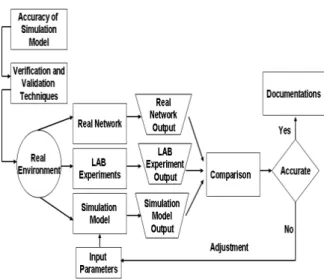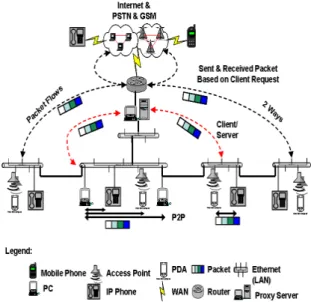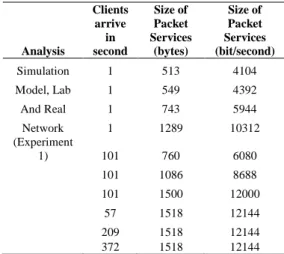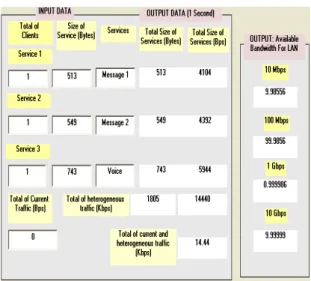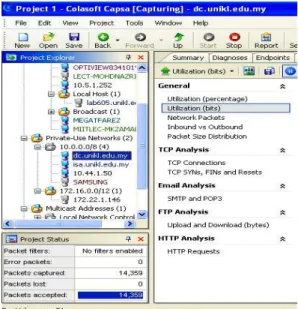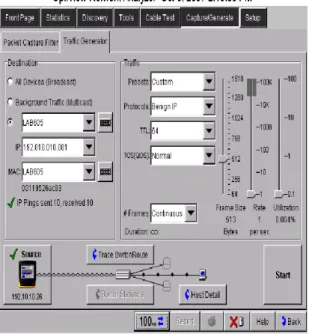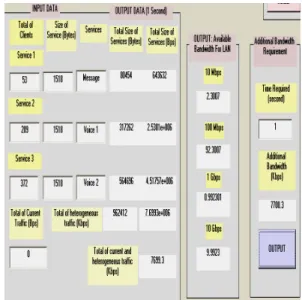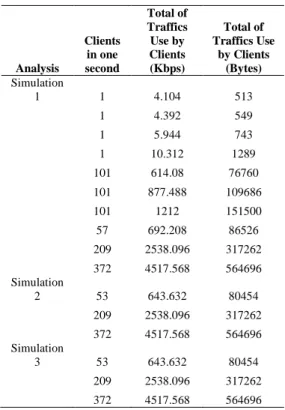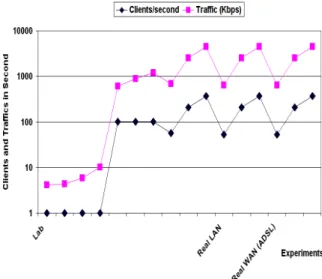DEVELOPMENT OF SIMULATION MODEL IN
HETEROGENEOUS NETWORK ENVIRONMENT:
COMPARING THE ACCURACY OF SIMULATION MODEL
MOHD NAZRI ISMAIL, ABDULLAH MOHD ZIN
Faculty of MIIT, University Kuala Lumpur, MalaysiaFaculty of Computer Science, UKM, Malaysia E-mail: mnazrii@miit.unikl.edu.my, amz@ftsm.ukm.my
Abstract: We present a novel approach for the measurement and estimation of network traffic management between network nodes in heterogeneous environment. This research investigates performance evaluation of network traffic on heterogeneous services and technologies environment. We propose an enhanced equation to evaluate the performance of network traffic management via Little Law and Queuing theory to improve the evaluation algorithm. To get accuracy results on the performance of simulation model, we measure (verify and validate) data from lab experiment and real network environment. We use network management tool to capture those data and Fluke Optiview device (network analyzer) to generate traffic. As a result, this simulation model can provide a good approximation of the real traffic observed in the real network environment. Through laboratory and field experiments, it shows that the model via simulation is capable of approximating the performance of network traffic management over heterogeneous services and techniques within a minimum error range.
Keywords: Simulation Model, heterogeneous services, traffic management, generate traffic
1. INTRODUCTION
Traffic management refers to the set of traffic controls within the network that regulate traffic flows for maintaining the usability of the network during conditions of congestion. Without effective traffic controls, networks are vulnerable to possible congestion when the offered traffic exceeds the network capacity, leading to serious deterioration of the network performance.
Considerable research has been conducted to model and quantify the performance of heterogeneous services and technologies (e.g (Kawasaki, S et. al. 2006), (A. Tsalgatidou et. al. 2006), (Qingwen Liu et. al. 2006)). Accurate measurements and analyses of network traffic characteristics are essential for robust network performance and management. However, no current research specifically focuses on using queuing theory to measure heterogeneous services and technologies performance, which is the object of this research. Queuing theory (Ramon Puigjaner 2003) has been used as an effective tool to model performance in several technical and social contexts. Evaluating the performance of a computer networking usually involves constructing an appropriate model to predict the heterogeneous environment behaviour via simulation model. The heterogeneous environment model is then analyzed and simulated using mathematical techniques. Mathematical models describe the heterogeneous
environment with a set of equations. For example, several flow-level network traffic models have been proposed to describe/stimulate (S. Fredj et al. 2001), (Guojun Jin, Brian L. Tierney 2003), (Jing Cong, Bernd E. Wolfinger. 2006). These models have been used to study fairness, response times, queue lengths and loss probabilities under different assumptions and using a variety of mathematical techniques. Queuing theory has been widely used to model and analyze the network performance of complex systems involving services, communication systems, computer networks and vehicular traffic. In contrast to other works in the literature (e.g., (S. Ben Fredj et al. 2001), (T. Bu, D. Towsley 2001), (A.A. Kherani, A. Kumar. 2000)), we developed simulation model to measure the performance of heterogeneous environment. Our model can be used to generate representative packet traffic in a live network environment or in a simulated environment. The benefits include the effective bandwidth and traffic over heterogeneous environment with and without considering the networks packet loss ratio of the current traffic (real traffic).
The significant of this study was to develop a simulation model to measure the performance of network traffic management in heterogeneous network environment using Queuing theory. This model could assist network administrators to design and manage heterogeneous network systems. This simulation model can be used in various services
and technologies to measure heterogeneous environment. Therefore, this simulation model is designed to: i) predict the performance of various services (e.g. video, audio, voice and message) in order to aid technology assessment and capacity planning; ii) predict the expected behavior of new services and designs through qualitative or quantitative estimates of network performance; iii) assist network administrator to prepare, propose, plan and design network topology more effective and systematic; and iv) conduct ‘What-If’ analysis for evaluating heterogeneous network environment performance.
Moreover, in the future, the integration of data and communication services, almost every ‘Internet Ready’ device will be a communicable device (Qigang Zhao et al. 2005). With the availability of this infrastructure, users are now demanding and expecting more services (C. Barakat et al. 2003), (T. Bu, D. Towsley 2001). Convergence is pushing towards an environment that requires new investment in infrastructure and able to support the delivery of rich services (various services), applications and content. For example, connecting computers to phone, browsing websites with cell phones or reading emails on TV screens to illustrate idea of convergence (Podhradsky P. 2004), (S. Fredj et al. 2001). In addition, more people are using multimedia services such as MMS, WAP, i-mode or push-to-talk. GPRS (General Packet Radio Service) is an overlay on GSM networks that allows this kind of end-to-end IP-based packet traffic from mobile devices to the Internet (Georges Nogueira 2006). Network deployment is growing increasing complex as the industry lashes together a mix of wired and wireless technologies into large-scale heterogeneous network architecture and as user applications and traffic continue to evolve. Faced with this growing complexity, network designers and researchers almost universally use simulation in order to predict the expected performance of complex networks (John Heidemann et al. 2001). Modeling the Intranet or Internet traffic is an important issue. It is unlikely that we will be able to understand the traffic characteristics, predict network performance, or design dimensioning tools without simulation models. The successful evolution of the Internet is tightly coupled to the ability to design simple and accurate models (Chadi Barakat et al. 2002). Many factors may contribute to the congestion of network interface, such as a heavy load in the network that usually generates higher traffic. Once the number of requests exceeds the maximum capability of network, many clients will not able to receive responses from the network (J.kontio, R.Conradi. 2002). Thus, this research is critical to be conducted in order to predict and measure of network traffic management in heterogeneous environment.
2. PROBLEM STATMENTS
In the 21 century, a network infrastructure is based on multi-service implementation over convergence of network medium such as ISP, PSTN and GSM (Kyung-Hyu .L et al. 2003), (Jianqiang Li, Zhaohao Sun 2004). Availability of various services has produced multi-traffic in network infrastructure. Therefore, multi-traffic in the network infrastructure has become more complex to observe and analyze (Xianxin Jiang et al 2003), (Binh Thai et al. 2003), (Podhradsky P. 2004). Today, retrieving and sending information can be done using a variety of technologies such as PC, PDA, fix and mobile phones via the wireless, high speed network, ISDN and ADSL lines that are more prone to heterogeneous environment, but unfortunately the optimal capability of technologies are not fully realized. The main factors of network congestion are related to network design and bandwidth capacity (J. Curtis, T. McGregor, 2001). Nevertheless, few studies have been conducted to evaluate the application of computer network technologies and services over heterogeneous environment especially in Higher Education Institutes. Algorithms for actively measuring network physical and available bandwidths have been researched for many years. Many tools have been developed, and only a few tools have successfully achieved a close estimation of network traffic management (Qingwen Liu et. al 2006).
Therefore, retrieving and sending information over heterogeneous environment using convergence of technologies in Higher Educational Institutes should be analyzed and evaluated via simulation model. We have setup a pilot test-bed (real network environment) to analyze and measure of network traffic at University of Kuala Lumpur in Malaysia. This study posits several research questions: i) what is the performance level of the network traffic; and ii) Is the simulation model for evaluating and measuring the heterogeneous environment performance effective?
3. METHODOLOGIES
Whatever modelling paradigm or solution techniques in heterogeneous environment model development are being used, the performance measures extracted from a simulation model must be a good representation of the real network environment. Inevitably, some assumptions must be made about the real network in order to construct the heterogeneous environment model. Figure 3.1 shows the overall framework of the simulation model. There are four performance techniques to validate the simulation model: i) graphical representation - graphical representation is representing the model output data with various graph; ii) tracing – tracing
is a technique to determine if the logic of the simulation model is correct; iii) parameter variability – sensitivity analysis is a validation technique where one changes the values of the input to determine the effect upon the model and its output; and iv) predictive validation – predictive validation is used to compare the model’s prediction with real network environment. In addition, there are two techniques to judging how good a model is with respect to the real network (Osman Balci 2004): i) it must ascertain whether the simulation model implements the assumptions correctly (model verification); and ii) assumptions which have been made are reasonable with respect to the real network (model validation).
Figure 3.1: Simulation Model Development Methodology
Figure 3.2: Simulation Model Verification and Validation Methodology
There are three aspects, which should be considered during simulation model validation: i) assumptions; ii) input parameter values and distributions; and iii)
output values. Comparison with a real network is the most reliable and preferred method to validate a simulation model (refer to Figure 3.2).
Assumptions, input values, output values, workloads, configurations and network system behaviour should all be compared with those observed in the real network.
4. PROPOSED SIMULATION MODEL
DEVELOPMENT FOR NETWORK TRAFFIC MANAGEMENT
The traffic is characterized based on parameters such as the volume of traffic generated, the packet or client inter-arrival times, size of packet services and protocol types and application that generated the traffic. Many different types of modeling and simulation applications are used in various disciplines such as acquisition, analysis, education, entertainment, research and training (David R.Gerhan, Stephen M. Mutula 2005). In the figure 4.1, theoretical model is based on a random distribution of service duration. “Request” defines the way clients use the computer network to request services, while, “Response” represents the way clients receive services from the server. Simulation model is divided as follows: i) to study physical of real heterogeneous network environment; ii) transform physical of real heterogeneous network environment into logical model; and iii) develop and implement the heterogeneous simulation model. 4.1 Physical Model of Real Heterogeneous Network Environment
Before we start to develop simulation model of heterogeneous network environment, we need to define the situation of heterogeneous environment in real world. Figure 4.1 shows the network heterogeneous environment in real world. Then we need to transform from heterogeneous environment in real world into logical model. The logical model is the phase where mathematical techniques are used to stimulate heterogeneous environment.
4.2 Logical Model of Heterogeneous Network Environment
Figure 4.2 depicts the open queuing network based on Queuing theory (M/M/1) will use to develop logical model of heterogeneous environment for network traffic management. Parameters like size of packet services and number of clients are used to ‘characterize’ the application traffic.
4.3 Development of Heterogeneous Network Environment Model
and little law theories that capture the performance characteristics of network traffic operations. A link refers to a single connection between routers and hosts. The link bandwidth is the rate at which bits can be inserted into the medium. The faster bandwidth the more bits can be placed on the medium in a given time frame (Sommers, Joel, Barford, Paul 2004).
Figure 4.1: Real Heterogeneous Network Environment at Main Campus
Figure 4.2: Logical model of Heterogeneous Network Environment at Main and Branch Campus At this stage, we assume the data are transported between the two network sites (source and destination) as previously shown in Figures 4.1 and Figure 4.2. Table 4.1 shows the parameters that have been used in the model development. In open queuing network, the throughput of the heterogeneous network environment is determined
by the input rate in the system. Table 4.2 summarizes all the parameters used in the model. Table 4.3 also shows the input and output parameters.
Table 4.1: Notations for Original Queuing and Little Theories
Model Parameters
Meaning
N Average numbers of clients in the system
T Average time a client spends in the system (second)
Clients arrival rates
µ Service rate in second 1/µ Mean service times
ρ
Traffic intensityTable 4.2: Notations for Model Development Model
Parameters
Meaning Jum_klient Numbers of clients P (P1,P2,P3,...Pm) Various of services
C (CLAN, CWAN) Size of Bandwidth on LAN and WAN interface ports Tfik_Semasa Total of current traffics in
the network P1 Client uses single service Tp Throughput or bandwidth allocation base on time service required (second)
Size of packet service request by single client
( traffic)
µ
JumlahTotal size of packet services request by clients
(traffic)
Table 4.3: Input and Output Metrics Use for Model Development
Input Parameter Output Parameter
Numbers of clients use services
Size of bandwidth in kilobits per second
(Kbps) Size of packet
services in bytes (Bytes)
Total size of packet services in bytes and bit
per second (Bytes and bps)
Total of current traffics in the network (bps)
Total of heterogeneous and current traffics in
kilobits per second (Kbps) Time require in
second
Total of heterogeneous traffic in bit per second
(bps)
λ
1 klient
The original Queuing theory is defined as an average number of clients in the system (variable name is ‘N’) in equation 1. Equation 2, defined as traffic intensity use by clients in the system. Equation 1, 2, 3 and 4 are derived based on logical model that has designed to meet requirements for heterogeneous network environment to measure bandwidth link availability. Logical model is derived and formulated in a single service (homogeneous concept) as in equations 5, 6, 7, 8, 9, 10 and 11. Then, the logical model is derived to the heterogeneous network environment in equations 12, 13, 14, 15 and 16.
---- (1) --- (2)
Expectation value for traffic intensity:
--- (3)
Average time per clients in the system;--- (4)
Numbers of Clients use single service for accessing network server
Bandwidth Capacity = Size of Packet Services +
Current Traffic --- (5)--- (6)
--- (7) Traffic Current ] C ) 1 klient * ) klient _ Jum (( C [ C 1 Tp + − ≥µ
---(8)
Traffic Current ] 1 klient * ) klient _ Jum ( C [ 1 Tp + − ≥µ
---- (9)
Traffic Current )] 1 klient * ) klient _ Jum (( Tp 1 [ C≥ +µ
+--- (10)
Additional bandwidth link allocation to support traffic usage:
--- (11)
Total numbers of Clients use various services foraccessing network server in Heterogeneous Environment (Jum_klient*P1)+(Jum_klient*P2)+ (Jum_klient*P3)+…+(Jum_klient*Pm)=
µ
Jumlah --- (12) --- (13) Traffic Current ) ] C ) ( C C[ 1 ( T Jumlahµ
p + − ≥ ---- (14) ---- (15)Additional bandwidth link allocation to support traffic usage in heterogeneous network environment:
Traffic
Current
)]
(
T
1
[
C
µ
Jumlah p+
+
≥
--- (16)Figure 4.3 shows how the model has been formulated from real network environment to simulation model. The main valuable aspects of the simulation study is to explain and understand real world phenomena that are costly to perform in the laboratory or difficult to collect in field experiments. A successful simulation model that is able to provide a sufficiently credible solution that can be used for prediction. Since it is not feasible to construct a simulation model that represents all the details and behaviors of the real network, some assumptions must be made about the real network to construct a simulation model. Therefore, a simulation model is an abstract representation of real network environment.
T
*
N
=
λ
µ λ µ λ ρ = < 1; < ρ − ρ = 1 } n { E ) 1 ( 1 1 N T ρ − µ = λ − µ = λ = Traffic Current ) /C] P * t) (Jum_klien [1 1 C 1 ( T 1 p + − ≥ Traffic urrent C ) /C] * t) (Jum_klien [1 1 C 1 ( Tp klient1µ
+ − ≥ Traffic Current ]] * nt) [(Jum_klie T 1 [ C klient1 p+µ
+ ≥ Traffic Current ] C / 1 [ 1 C 1 T Jumlahµ
p + − ≥ Traffic Current ) )] ( [C 1 ( T Jumlahµ
p + − ≥Figure 4.3: Model and Simulation Development Phases
5. SIMULATION MODEL ARCHITECTURE A simulation model is set of assumptions concerning the operation of the system, expressed as mathematical, logical and symbolic expressions between the object of interests (entities) of the system. Performance modeling can be done using simulation models or analytical models. Performance modeling is typically used when actual systems are not available for measurement or, if the actual systems do not have test points to measure every detail of interest. Performance modeling may further be classified into simulation modeling and analytical modeling. Simulation models may further be classified into numerous categories depending on the mode/level of detail of simulation. Analytical models usually use probabilistic models, queuing theory, Markov models or Petri nets (Fidel C. et al. 2007). Figure 5.1 shows simulation model architecture, which is used to measure heterogeneous network environment.
Figure 5.1: Simulation Model Architecture of Heterogeneous Network Environment
This simulation model allows fast evaluation of important performance measures, such as network utilization and traffic, in terms of measurable or controllable parameters; it also can be used as a system management tool. Outputs of the simulation model represent an estimate of the real outputs for the physical real network. Network utilization rate is the ratio of current network traffic to the maximum traffic that the port can handle. It indicates the bandwidth use in the network. High network utilization rate indicates the network is busy whereas low utilization rate indicates the network is idle. Three sets of experiments were conducted in simulation model, lab and real network environment with different scenarios at University of Kuala Lumpur. Table 5.1 shows several variables bytes were performed from source (client) to destination (server) to access network server. A congested network can be modeled by increasing the number of clients, reducing the bandwidth link, or by adding size of services.
Figures 5.2, 5.3 and 5.4, show simulation model interface and output for evaluating heterogeneous network environment performance. The output results depend on the input variables. We demonstrate several samples from our simulation model to predict and estimate number of traffics, additional bandwidth requirement and throughput of traffic in Local Area Network. Figure 5.3 shows the prediction of network traffic results without considering current traffic in the LAN. Figure 5.4 shows prediction of network traffic results with considering current traffic in the network and throughput based on time required. For example, Figure 5.4 shows throughput of the current and heterogeneous traffic is 1014.44 Kbps.
Table 5.1: Size of Services and Numbers of Clients Parameters Analysis Clients arrive in second Size of Packet Services (bytes) Size of Packet Services (bit/second) Simulation 1 513 4104 Model, Lab 1 549 4392 And Real 1 743 5944 Network 1 1289 10312 (Experiment 1) 101 760 6080 101 1086 8688 101 1500 12000 57 1518 12144 209 1518 12144 372 1518 12144
Analysis Clients arrive in second Size of Packet Services (bytes) Size of Packet Services (bit/ second) Simulation 53 1518 12144 Model, Lab 209 1518 12144 And Real 372 1518 12144 Network (Experiment 2) Simulation 53 1518 12144 Model, Lab 209 1518 12144 And Real 372 1518 12144 Network (Experiment 3)
Figure 5.2: Main Menu for Various Communication Technologies
Figure 5.3: Simulation Model Interface and Output for Network Traffic Prediction and Estimation without Consider Any Current Traffic
Figure 5.4: Simulation Model Interface and Output for Network Traffic Prediction and Estimation with Considering Current Traffic
Figure 5.5: Simulation Model Output for Network Traffic Prediction and Estimation without Consider Any Current Traffic in Graphical Interface
Output of network traffic management that captured by simulation model is based on size of services and number of clients. In addition, this simulation model can also predict and estimate the variable parameters in graphical output interface, see Figure 5.5. This graphical output interface can provide simulation model is easier to analyze and measure the network traffic performance.
Low bandwidth link capacities via LAN and WAN interface port can affect network utilization and number of clients for accessing the network. When network utilization rate exceeds the threshold under normal condition, it may cause low transmission speed, intermittence and delay. Through analyzing and monitoring network traffic rate, we will get an idea whether the network is idle, normal or busy. It also helps network administrator to set proper
benchmark and troubleshoot network failures with the network traffic rate.
6. VERIFICATION AND VALIDATION OF SIMULATION MODEL
In this section, we verify the little law and queuing theories for heterogeneous simulation model environment between two networks through experiments. The experiments are composed of Lab and LAN experiment to real network environment. Several tests were performed to evaluate the tuned parameters and the values that better ‘mimic’ the characteristics of the real networks. Lab experiment is based on ideal network in which there is no packet losses, no jitter in delays and network bandwidth is sufficient for all requirements. While, real experiment is based on real network and need to consider as follows: i) network bandwidth is limited and is not enough for all application and users at the same time; ii) delay due to the network overloads; and iii) packet losses.
6.1 Experimental of Laboratory and Real Network Setup
We used a network management application to capture traffic between two networks link in the lab and real network experiments (see Figure 6.1). Figure 6.2 and Figure 6.3 show the experimental setup of lab and real network used in our tests. The network lab used switch with Gigabit Ethernet ports, Router ports and Fluke Optiview device can be configured to insert size of packet services and number of clients to generate traffic into the network interface port (see Figure 6.4 and Figure 6.5). By using varying number of clients and size of packet services, we are able to simulate network traffic, see Table 5.1.
Figure 6.1: Network Management Application
Figure 6.2: Experimental Laboratory for Network Environment Setup
Figure 6.3: Experimental Laboratory for Real Network Environment Setup
6.2 Lab and Real Network Experiment
We have setup a pilot test-bed LAB of network utilization and traffic measurement that generates measurement data to analyze network performance at the main campus. The pilot test-bed LAB is based on local area network (LAN) and no traffic congestion occurs. In our pilot test-bed LAB, we used ‘UTP CAT 5’ cable to connect our equipment. The ‘UTP CAT 5’ cable can configure to support 10 Mbps and 100 Mbps bandwidths. Low
bandwidth link affects the size of packet services and number of clients’ access to the network server (see Figure 6.6).
Figure 6.4: Fluke Optiview Engine Setting for Size of Packet Services and Clients (Lab Experiment)
Figure 6.5: Fluke Optiview Engine Setting for Size of Packet Services and Clients (Real Network Experiment)
Therefore, we run network management application to measure traffic performance. Three sets of experiments were conducted with different scenarios (see Table 5.1). Fluke Optiview device is able to generate maximum traffic to 1518 bytes (12144 bits) only in the real network (see Figure 6.4 and Figure 6.5). In addition, this device is limited to Ethernet
interface 10/100 Mbps and fiber optic interface 100 Mbps (see Figure 6.7).
Figure 6.6: Bandwidth Link Capacity for LAN and WAN Measurement
Figure 7.7: Optiview Network Analyzer Device to Generate Network Traffic
We used the same input variables that have been used in simulation model (see Table 5.3 and Table 5.4) to estimate our data that must be closely resemble to lab and real network environment. Figure 6.8 and Figure 6.9 show the output results capture by network management application to measure network traffic via real network (lab, LAN and WAN using ADSL technology). In addition, this simulation model capable to measure maximum throughput base on time series for identifying whether the network traffic has achieved maximum bandwidth link capacity (see Figure 6.10, Figure 6.11, Figure 6.12 and Figure 6.13). We conclude that base on our findings, the simulation model is able to predict and estimate network traffic usage for real network environment (see Table 6.1).
Figure 6.8: Lab Experiment Result Capture by Network Management Application
Figure 6.9: LAN and WAN (ADSL technology) for Real Network Result
Figure 6.10: Network Traffic Management over Ethernet Technology Using Simulation Model Measurement (Time Series: 1 second) without Consider Any Current Traffic
Figure 6.11: Network Traffic Management over Ethernet Technology Using Simulation Model Measurement (Time Series: 1 second) in Graphical Interface without Consider Any Current Traffic
Figure 6.12: Network Traffic Management over Ethernet Technology Using Simulation Model Measurement (Time Series: 0.001 second) without Consider Any Current Traffic
Figure 6.13: Network Traffic Management over Ethernet Technology Using Simulation Model Measurement (Time Series: 0.001 second) in Graphical Interface without Consider Any Current Traffic
Our branch campus is using 2 Mbps ADSL technology connected to Internet. Therefore, from the prediction and estimation result, this simulation model shows that ADSL technology measurement indicate negative value. Negative value means that network traffics are achieved the maximum bandwidth capacity for ADSL technology (see Figure 6.14 and Figure 6.15)
Figure 6.14: Network Traffic Management over ADSL Technology Using Simulation Model (Time Series 1 Second) without Consider Any Current Traffic
Figure 6.15: Network Traffic Management over ADSL Technology Using Simulation Model (Time
Series 0.001 Second) without Consider Any Current Traffic
Table 6.1: Network Traffic Management Measurement Result Using Simulation Model
6.3 Comparison of Real Network and Simulation Model
Figure 6.16 and Figure 6.17 show a comparison between simulation model and real network using Ethernet interface (Lab and LAN) and WAN interface (ADSL). The result shows both scenarios use in simulation model and real network are able to predict and measure network traffic usage. The simulation model provides relatively accurate results when compared to the real network over Ethernet and ADSL Technology. As a result, this research shows that the simulation model can predict lab and real network experiments with minimum relative error rates (see Table 6.2 and Table 6.3). From the simulation model and real network results, it confirms that low bandwidth link can affect size of packet services and number of clients to access the network server in heterogeneous environment. Therefore, from the prediction and estimation result, this simulation model can assist network administrator to plan, propose and design network topology more systematic and efficiently for heterogeneous network environment.
Figure 6.16: Numbers of Clients and Size of Packet Services Using Simulation Model
Table 6.2: Measurement of Network Traffic Management Using Simulation Model
Analysis Clients in one second Total of Traffics Use by Clients (Kbps) Total of Traffics Use by Clients (Bytes) Simulation 1 1 4.104 513 1 4.392 549 1 5.944 743 1 10.312 1289 101 614.08 76760 101 877.488 109686 101 1212 151500 57 692.208 86526 209 2538.096 317262 372 4517.568 564696 Simulation 2 53 643.632 80454 209 2538.096 317262 372 4517.568 564696 Simulation 3 53 643.632 80454 209 2538.096 317262 372 4517.568 564696
Figure 6.17: Numbers of Clients and Size of Packet Services in Real Network Experiments
Table 6.3: Measurement of Network Traffic Management (Lab and Real Network Experiments)
Analysis Clients in one second Total of Traffics Use by Clients (Kbps) Total of Traffics Use by Clients (Bytes) Lab Experiment 1 4.104 513 1 4.392 549 1 5.944 743 1 10.312 1289 101 614.08 76760 101 877.488 109686 101 1212 151500 57 692.208 86526 209 2538.096 317262 372 4517.568 564696 Real Network (LAN, Ethernet Technology) 53 643.632 80454 209 2538.096 317262 372 4517.568 564696 Real Network (WAN, ADSL Technology) 53 643.632 80454 209 2538.096 317262 372 4517.568 564696 7 CONCLUSION
In this article we have shown how an analytical queuing network model can be used to understand the behaviors of heterogeneous environment over LAN, WAN and Lab experiments. The most
apparent aspect is the network traffic usage due to size of bandwidth and number of clients. Our simulation model, has demonstrated that it can measure accurately the performance of heterogeneous services and technologies to access network server. Through laboratory and real network experiments, the simulation model is verified and validated for providing accurate performance information for various services. We believe the simulation modeling framework described in this study can be used to study other variations, tunings, and similar new ideas for various services and technologies. Network traffic rate will directly affect the network performance. In network management, by monitoring and analyzing network traffic rate we can monitor the performance of the network, thus to study whether network is normal, optimal or overloaded. Network traffic rate also plays an important role in benchmark setting and network troubleshooting.
REFERENCES
[J.kontio & R.Conradi. (2002). “Evaluating the Performance of a Web Site via Queuing Theory”
Software Quality - ECSQ 2002: 7th International Conference, Helsinki, Finland, June, Springer-Verlag Berlin Heideberg, pp. 63-72.
John Heidemann, Kevin Mills, Sri Kumar. (2001).”Expanding Confidence in Network Simulation”, IEEE computer, Vol. 15 (5), p.p 58-63. Ramon Puigjaner, (2003). “Performance Modelling of Computer Networks”, IFIP/ACM Latin America Networking Conference 2003, October 3 - 5, La Paz, Bolivia. ACM.
Fidel C., et al. (2007). “Performance analysis of distributed information retrieval architectures using an improved network simulation model”. Information Processing and Management, pp. 204-224, Science Direct.
Georges Nogueira. (2006). “Measurement based validation of GPRS/EDGE Analytical Models” Infocom Student Workshop.
Chadi Barakat, Patrick Thiran, et al. (2002). “A flow-based model for Internet backbone traffic”. Proceedings of the 2nd ACM SIGCOMM Workshop on Internet measurement, Marseille, France, pp. 35 – 47.
S. Ben Fredj, T. Bonald, A. Proutiere, et al. (2001). “Statistical Bandwidth Sharing: A Study of Congestion at Flow Level”, ACM SIGCOMM. T. Bu and D. Towsley, (2001). “Fixed Point Approximation for TCP behavior in an AQM Network”, ACM SIGMETRICS.
A.A. Kherani and A. Kumar. (2000). “Performance Analysis of TCP with Nonpersistent Sessions”, Workshop on Modeling of Flow and Congestion Control, INRIA, Ecole Normale Superieure, Paris. Osman Balci. (2004). “Quality Assessment, Verification and Validation of Modeling and Simulation Applications”. Proceeding of Winter Simulation Conference. Vol. 1, Issue , 5-8, pp. 129 Qigang Zhao; Xuming Fang; Qunzhan Li; Zhengyou He. (2005). “WNN-based NGN traffic
Prediction”. ISADS 2005. Proceedings Autonomous Decentralized Systems, pp. 230-234.
Kyung-Hyu .L; Kyu-Ok .L; Kwon-Chul .P; Jong-Ok .L & Yoon-Hak .B. (2003). “Architecture to be deployed on strategies of next-generation networks”. Communications ICC '03. The IEEE,Vol. 2, pp. 819 – 822.
Xianxin Jiang; Fangchun Yang; Hua Zou. (2003). “A novel architecture to customer service management for the NGN”. ICCT 2003. International Conference, 1: 123-126.
David R.Gerhan & Stephen M. Mutula. (2005). “Bandwidth bottlenecks at the University of Botswana”, Published by Emerald Group, Vol. 23 (1), pp. 102-117.
Jianqiang Li; Zhaohao Sun. (2004). “Internet/Web technology in higher education in China”. Advanced Learning Technologies, Proceedings. IEEE International Conference, pp. 993 – 997.
Binh Thai, Rachel Wan, Aruna Seneviratne, Thierry Rakotoarivelo. (2003). “Integrated Personal Mobility Architecture: A Complete Personal Mobility Solution”.Kluwer Academic Publishers. Podhradsky, P. (2004). ” Migration scenarios and convergence processes towards NGN (present state and future trends)”. Electronics in Marine Proceedings Elmar. 46th International Symposium, pp. 39-46.
J. Curtis and T. McGregor, (2001). "Review of bandwidth estimation techniques, " in Proc. New Zealand Computer Science Research Students' Conf., New Zealand, vol. 8.
C. Barakat, P. Thiran, G. Iannaccone, C. Diot, and P. Owezarski. (2003). “Modeling Internet backbone traffic at the flow Level”. IEEE Transactions on Signal Processing (Special Issue on Networking). T. Bu and D. Towsley. (2001). “Fixed point approximation for TCP behavior in an AQM
network”. In Proceedings of ACM SIGMETRICS ’01, San Diego, CA.
S. Fredj, T. Bonald, A. Proutiere, G. Regnie, and J. Roberts. (2001). “Statistical bandwidth sharing: A study of congestion at flow level”. In Proceedings of ACM SIGCOMM ’01, San Diego, CA.
Sommers, Joel; Barford, Paul. (2004). “Self-Configuring Network Traffic Generation”. In Proceedings of ACM Internet Measurement Conference, October.
Guojun Jin & Brian L. Tierney. (2003). ‘System capability effects on algorithms for network bandwidth measurement’. Proceedings of the 3rd ACM SIGCOMM conference on Internet measurement, pp. 27-38.
Jing Cong & Bernd E. Wolfinger. (2006). “A unified load generator based on formal load specification and load transformation”, Proceedings of the 1st international conference on Performance evaluation methodolgies and tools, ACM International Conference Proceeding Series, Pisa, Italy,Vol. 180 (53).
Kawasaki, S., Niwa, et. al. (2006). “A Study on Formulation of the Ubiquitous Cloud Model”, Mobile Data Management, MDM. 7th International Conference, pp. 148 – 148.
A. Tsalgatidou, G. Athanasopoulos & et. al. (2006). Developing scientific workflows from heterogeneous services, ACM SIGMOD, Vol. 35 (2 ), pp. 22 – 28.
Qingwen Liu, Shengli Zhou, et. al,. (2006). “Cross-layer modeling of adaptive wireless links for QoS support in heterogeneous wired-wireless networks”, Wireless Networks, Vol. 12 (4), Kluwer Academic Publishers.
